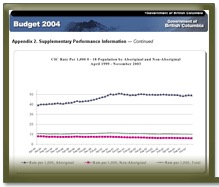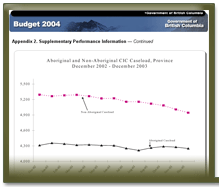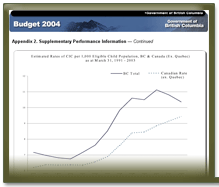| Measure in 2004/05 – 2006/07 Service Plan |
Rationale |
Definition |
| 1. Satisfaction of individuals with services received. |
New measure — a component of the information that
will be collected as part of a ministry survey. Information
on how individuals feel about their participation in the community
will help to measure progress toward Goal 1 by compiling baseline
information for comparison in subsequent years. |
The satisfaction rate of persons with developmental disabilities
or their advocates and family members of children with special
needs. |
| 2. Number of adults and families of children with special
needs who receive direct or individualized funding. |
Current measure — combines both adults and children
(separate measures in previous plan). Individualized funding
is a major strategy in the Service Plan and is consistent
with the Community Living Services [CLS] Service Transformation
initiative that is intended to improve outcomes for adults
with developmental disabilities and for children and youth
with special needs and gain cost efficiencies in the service
delivery system. |
Number of adults receiving direct or individualized funding
combined with the number of families of children with special
needs who receive direct or individualized funding (Interim
Early Intensive Intervention, Extended Autism Early Intervention,
and At Home Respite). |
| 3. Percentage of children (4-6) and youth (17-19) with special
needs that have completed Transition Plans.
|
New measure — based on CLS Service Transformation
initiative. For children and youth with special needs and
their families critical transitions can be traumatic and the
lack of a Transition Plan could result in the loss of key
developmental milestones and unsuccessful school transitions.
Having a transition plan in place for these individuals will
increase their chances for success. |
Percentage of children turning 19 and being referred on
to adult CLS programs who have a completed, agreed upon and
operational Transition or Personal Service Plan initiated
by workers who have responsibility for Children and Youth
with Special Needs [CYSN] and confirmed by adult CLS worker
and supervisor. |
| 4. Percentage of individuals served in family model homes. |
New measure — based on CLS Service Transformation
goals. Where appropriate, based on the assessed needs of clients,
family model care is the residential setting of choice for
inclusivity and community living for adults with developmental
disabilities. Encouraging these placements, when they are
appropriate, is best practice and one of the keys to ensuring
sustainable CLS services in the future. |
Percentage of all adults receiving CLS residential services
who are being served in a family model home versus those being
served in staffed residential facilities.
Note: This measure will continue to evolve as innovations
to service delivery are made in the context of best practices
and the principles of self-determination and social inclusion.
|
| 5. Number of new public/private partnerships to raise awareness
and commitment to Fetal Alcohol Spectrum Disorder prevention. |
New measure based on Early Childhood Development [ECD] service
transformation initiative. FASD awareness is a critical component
of the Provincial ECD Strategy and will address the prevention
of FASD through public and professional awareness and education
on the risks of alcohol consumption during pregnancy. |
Public and professional awareness of risk of alcohol consumption
during pregnancy to address the prevention of FASD. |
| 6. Percentage of children up to age six on the wait list
for supported child care. |
New measure based on the Early Childhood Development [ECD]
service transformation initiative. The redesign of supported
child care services will provide flexible community service
options which are evidence based, address specific family
needs, promote family choice and include community environments
as support options. These options will increase options for
social inclusion and school readiness. |
Administration and eligibility for supported child care
services shifted to community-based agencies to increase access
and reduce waitlists for children up to six years of age. |
| 7. Number of community-based initiatives designed to prevent
Fetal Alcohol Spectrum Disorder [FASD]. |
New measure- based on Early Childhood Development [ECD]
service transformation initiative. FASD prevention initiatives
are expected to contribute to a reduction in the incidence
of FASD, resulting in improved health status and reduced life-long
costs that would otherwise be associated with FASD at the
community level. |
Community initiatives that communities adopt that focus
on preventing FASD (FAS, FAE). |
| 8. Number of Aboriginal communities with early childhood
development initiatives. |
Continuing measure — changed slightly to clarify the
emphasis on the number of initiatives not communities. Measures
progress toward the strategic shift — Building capacity
within Aboriginal communities to deliver a full range of services
with emphasis on early childhood and family development. |
Counts the number of early childhood development initiatives
in Aboriginal communities. One initiative can serve more than
one community. Aboriginal community is as defined by the community. |
9. Number of
out-of-care placements. |
New measure — based on Child and Family Development
[CFD] Service Transformation initiative. Out-of-care placements
build on family strengths and maintain the continuity of family
and community relationships, contributing to better outcomes
for children, youth and families. |
"Out-of-care placements" refers to children found to be
at risk who are placed with relatives, friends or through
other agreements rather than being in the temporary care of
the ministry. |
| 10. Percentage of child welfare interventions that are resolved
through alternative dispute resolution processes. |
New measure — based on CFD Service Transformation
initiative. Community-based alternative dispute resolution
processes are demonstrated to be effective and efficient in
resolving family and community issues, leading to better and
more timely outcomes for children and families. |
"Alternative dispute resolution processes": activities designed
to resolve disagreements between families and the ministry
regarding decisions in a child welfare intervention, without
using the court system; includes mediation, family group conferencing,
and traditional community processes to resolve disputes. |
| 11. Number of service delivery sites where collaborative
service approaches are in place. |
New measure — based on CFD Service Transformation
initiative. Integrated service delivery approaches that include
alternate community-based programs reduce the fragmentation
of child and family services and are more responsive to the
needs of the community, promoting better outcomes for children,
youth and families. |
Collaborative service approaches include ministry offices
partnering with other agencies (e.g., contracted service provider
organizations, health authority offices, schools) to provide
specific programming and services to achieve shared goals. |
| 12. Percentage of Aboriginal children in care served by
delegated Aboriginal agencies. |
Continuing measure — from previous plan. Providing
Aboriginal communities, children and families with effective,
culturally appropriate supports and services is the best means
to reduce the number of Aboriginal children in care. |
Number of Aboriginal Children in Care receiving child welfare
services in delegated Aboriginal agencies as a per cent of
total Aboriginal children in care. |
| 13. Percentage of Aboriginal children in care who are being
cared for by Aboriginal families. |
New measure based on CFD Service Transformation initiative.
Caring for Aboriginal children in care in Aboriginal families
is the best means of providing effective and culturally appropriate
supports and services. |
Percentage of Aboriginal children in care who reside in
Aboriginal foster homes, group homes, and specialized resources. |
| 14. Rate of youth in custody based on a proportion of all
12-17 year olds (per 10,000). |
Continuing measure — from previous plan. The number
of youth in the justice system is declining, demonstrating
progress toward implementation of the strategy to minimize
youth involvement in the criminal justice system by providing
treatment services and community-based alternatives to custody. |
Average annual (daily) admissions to the Youth Justice Institutional
Services per 1,000 children and youth age 12-17 years. |
| 15. Number of authorities established. |
Continuing measure — from previous plan. Tracks the
progress of the transition to community-based governance.
End state will be a permanent authority for Community Living
Services and the establishment of regional child and family
authorities. |
Number of authorities established based on assessment of
readiness. |
| 16. Reduce the ministry's regulatory burden by 40 per cent. |
Continuing measure — from previous plan, set government-wide
for all ministries. |
Required measure — government-wide initiative. |
| 17. Ministry rating of Enterprise-wide Risk Management implementation*. |
New measure based on a government-wide initiative; this
measure will better reflect service transformation objectives.
Risk is the chance of something happening that will have an
impact upon the achievement of objectives and includes events/circumstances
outside of the ministry's control. Risk management means
building a culture, processes, and structures for the effective
management of potential unanticipated events. |
Ratings on scale of 1-5 on ministry risk management "maturity"
on a number of factors in key risk management areas such as:
• organizational philosophy/culture re: risk management;
• risk management leadership and commitment;
• integration with other management practices and
systems;
• risk management capabilities; and
• risk management reporting and control.
|





